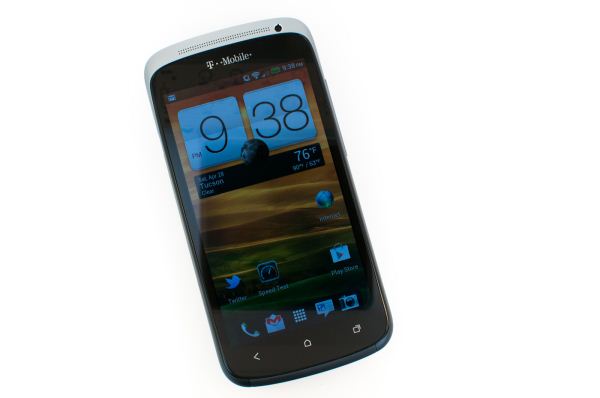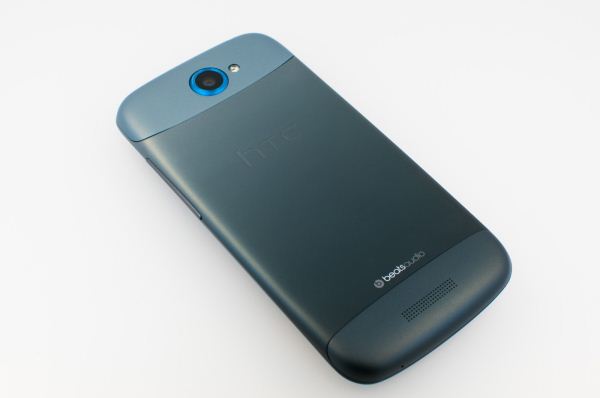HTC One S Review - International and T-Mobile
by Brian Klug on July 17, 2012 9:30 AM ESTIt took me a while to finish the One S review, partially because honestly I didn’t want to be done with it. Ok, well that's part of it, truth be told it took me far too long to finish the One S review, but I have some good excuses - a month full of abrupt life changes, a move across town, and a number of trips to exciting places covering the SGS3 announcement, Google I/O, and Windows Phone 8 all seemed to preclude hitting post on the One S review. The whole time, I've been using the T-Mobile One S with my own T-Mobile SIM and plan (the magical $30/mo prepaid one with unlimited SMS, 5 GB of full speed data, and 100 minutes) since getting it, and the device is almost always in my pocket alongside either the One X, SGS3, or Galaxy Nexus with my other AT&T line.
If you’re a T-Mobile customer in the USA, there’s no doubt about it that the HTC One S is the current number one or two device out there, thanks in part to that combination of DC-HSPA+ and new 28nm SoC. Even now that T-Mobile has the Samsung Galaxy S III, the One S still has a place at the top of the carrier’s lineup for shoppers that aren’t looking for the largest device, or value the metal construction. Since both are based on the same SoC, the differentiating factors really come down to display, camera, and other features. SGS3 obviously includes the bigger and better display, but HTC feels like it holds the upper hand in camera and construction. The rest is just personal preference. For international shoppers, their particular One S gets the plasma sputtered metal case in addition to none of the T-Mobile software preload.
Really the differentiator is the display, and LTE. With regards to the display, I initially thought that another 4.3" qHD SAMOLED display with PenTile would immediately turn me off, but HTC has done the best job I’ve seen thus far of getting that particular panel to a place where it doesn’t have a weird tint at every brightness level or insane amounts of sharpening. It blows my mind that Samsung can't get its own AMOLED panels tuned this well. With regards to LTE, there are still a number of carriers out there who don’t have LTE, but are instead looking to improvements on WCDMA to both increase capacity and deliver higher throughput. In my neck of the woods and other similar places where there's no AT&T LTE coming for the foreseeable year or so, going to a carrier with DC-HSPA+ in the interim does make some sense.
I really have to go back to what I started talking about in the first section - the One S has an absolutely phenomenal in-hand feel thanks to the combination of both that metal construction, and the center taper. Even in the supplied case, the device sort of fades away in the pocket in a way that is starting to become depressingly uncommon as OEMs push into much larger display sizes and form factors.












97 Comments
View All Comments
ltcommanderdata - Tuesday, July 17, 2012 - link
To go with the smallest screen size for a modern smartphone, the iPhone 4S also has the smallest battery as shown on the first chart on page 2. It'd be interesting o find out how display power consumption scales with screen size to see if they are scaling battery size fast enough to fully compensate, but big phones with big screens do tend to have big batteries so big screens shouldn't automatically mean bad battery life.Penti - Tuesday, July 17, 2012 - link
4S doesn't have HSPA+ baseband only 14.0 Cat 10 HSDPA. I.e. 14Mbit "4G-branding". In short small batteries, large screens, fast processors and gpus and power hungry baseband is what drains these devices. You need a significant larger battery to have a better battery life here. For most devices that isn't a priority. For example the iPad 3 gen has a larger battery then MBAir 11.amdwilliam1985 - Tuesday, July 17, 2012 - link
Please explain the 4G part to a friend of mine.She claims her 4G iPhone 4s with iOS 5.1.1 on AT&T network can't go through a day with moderate usage.
Penti - Tuesday, July 17, 2012 - link
What, it's just a 3G WCDMA baseband, no other radio or tech it shouldn't draw more power just because the icon says 4G in this 3.75G device. No smartphone survives more then a day with moderate usage, calls and what not. An 4s is spec'd at 8 hours talk time and 6 hours of internet use over 3G respectively. Play a game and the device is pretty much dead half day. Using apps that pull data over the wireless cellular network, talk for a few hours and play a game for 15 minutes and it should be pretty drained. If there is nothing wrong with the device then it is the usage that has to change to accommodate more battery life. If you need to talk for hours a day and be connected to chat, surf the web, use apps that leverage the internet and all that over the network you would need some solution to charge the phone over the day not matter what device you run.Why some people whine about early LTE phones is because they had bad dual baseband chips and about half the talk time. Pretty bad battery life surfing on LTE etc.
Spoelie - Tuesday, July 17, 2012 - link
I'm wondering if the battery tests have ever been redone following iOS updates. In my experience, the battery life gets progressively worse with every new update. In this case, doing the tests once on release day and reusing the numbers for months on end may not be the best approach.Anand Lal Shimpi - Tuesday, July 17, 2012 - link
I'll take the blame for this one. Notice the revamp of our tablet and OS X battery life tests? The smartphone web browsing test is in need of an update there as well. iOS has gotten a little too "good" at what we're doing there, at least in the web browsing test. The call and tethering tests are still great cross-platform indications of battery life.rd_nest - Tuesday, July 17, 2012 - link
I think we should also look at multimedia playback times. Run high profile video files to check battery rundown time. It's an important parameter as far mobile usage is concerned.The SGS3 (International) is getting pretty good numbers compared to US SGS3 models.
yvizel - Tuesday, July 17, 2012 - link
Saying 3.5'' vs. 4.3'' is not an accurate argument.If you come to think of it, the iphone is a smaller device, therefore packs a smaller battery (as you can see in the Battery Capacity chart).
Also, I would rather have a "slower" processor and more battery juice than have an octa-core @ 4GHz on a smartphone with 1 hour of usage!
Not all of us use smartphone for gaming or whatever. I guess that the more common usage is web, email, GPS and other basic stuff. So again, no need for zillion cores on a smartphone.
Oh, and great review! looks like a great device!
Connoisseur - Tuesday, July 17, 2012 - link
My point is that it's extremely difficult to compare phones of different size, resolution, screen type, OS and capacity. Even if you remove the OS out of the mix (so you can compare OS "efficiency"), the only comparison you can really make between two different devices is hours/battery capacity efficiency.At least when comparing laptops, you have some basis for comparison (comparable hardware or form factor for example).
amdwilliam1985 - Tuesday, July 17, 2012 - link
We can do the following 2 tests.1) Hack and put iOS on an Android device and run the same test against iPhone 4s.
2) Hack both device and put a custom OS on both and run the test.
This way we can see if it's software or hardware that's affecting the battery life.